January Itinerary in Japan Day 3 (Yamagata)
(Thursday, January 27)
Table of contents
1. Mt. Haguro Five-story Pagoda
1. Mt. Haguro Five-story Pagoda
In the morning, I left the Suiden Terrasse Hotel and headed for Mt. Haguro via Tsuruoka Station. The buses I used are as follows.
Depart Science Park at 8:37, Shonai Airport shuttle bus, arrive at Tsuruoka station at 8:46, fare Yen 330
Depart Tsuruoka Station at 9:43, Tsuruoka Haguro Sancho Line “bound for Ideha cultural museum”, arrive at Ideha cultural museum at 10:20
I bought a one-day ticket for Shonai Kotsu’s fixed‐route bus for Yen 2,000 at the Tsuruoka City Tourist Information Center in front of Tsuruoka Station on the 1st floor of FOODEVER. The round trip from Tsuruoka Station to Mt. Haguro costs Yen 2,500, so the one-day ticket is a great deal. There were few passengers other than me on the round-trip bus to Mt. Haguro.
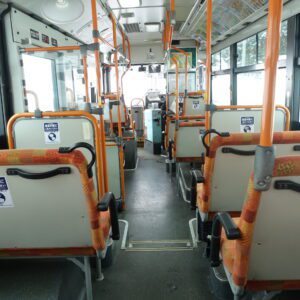
There is a bus stop called Science Park in front of the Suiden Terrasse Hotel, but the hotel staff said that the Suiden Terrasse Hotel has no means of transportation for local buses. This is because the bus stop at Science Park only stops at the Shonai Airport shuttle bus, and there is no exact departure time.
This is because the Shonai Airport shuttle bus departs at the arrival time of the plane. However, the estimated departure time of the bus is 10 minutes after the arrival of the plane, so you can know the approximate arrival time. Since there are only four flights a day to Shonai Airport, there are only four buses a day. If you want to go to Tsuruoka Station by bus from Suiden Terrasse Hotel, please use the Shonai Airport Limousine Bus.
The Five-Story Pagoda of Mt. Haguro is the only national treasure building in Yamagata Prefecture. I visited the Five-Story pagoda a few years ago in early summer. However, this is my first visit in winter.
First of all, you need to rent boots and poles at the Ideha cultural museum. Boots and stock are essential equipment before going to the Five-Story Pagoda because it is a snowy road. You can lend it for free. The Kongo cane used by Yamabushi is rented for Yen 100. I think it’s better to rent stock than a Kongo cane in winter.
Mt. Haguro is one of DEWA SANZAN (the three mountains of Dewa, Mt. Gassan and Mt. Yudono) and is a mountain of Shugendo (Japanese mountain asceticism incorporating Shinto and Buddhist concepts). You can reach the summit of Mt. Haguro by bus.Considering the timetable of the bus, it is more efficient to visit the five-storied pagoda first.
To get to the Five-Story Pagoda, enter from Zuishinmon. The inside of the Zuishinmon is the sanctuary of DEWA SANZAN.
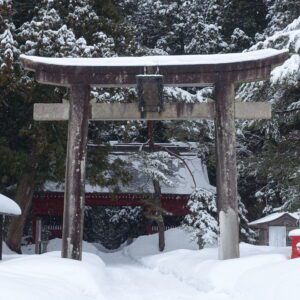
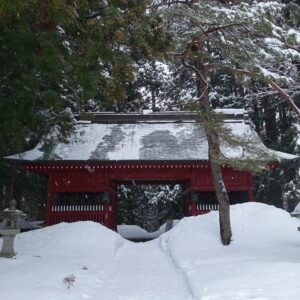
After passing through the Zuishinmon, you will reach a downhill called Mamakozaka. When you go down Mamakozaka, there are several subordinate shrines.
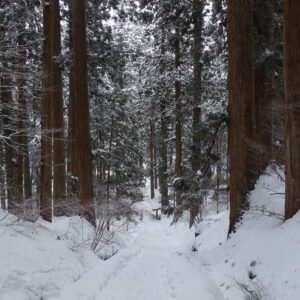
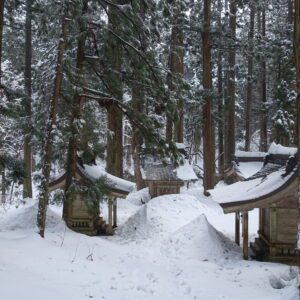

After crossing the subordinate shrines, you will see Suga Waterfall on your right. The river downstream of Suga Waterfall was covered with snow and was a very beautiful view.
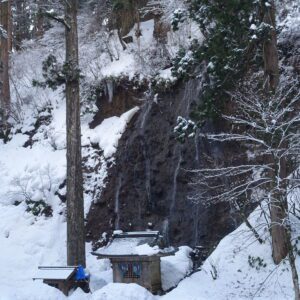
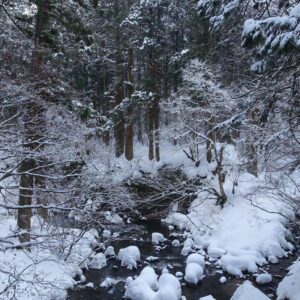
After crossing Suga Waterfall, you will climb a little uphill, and after passing the snow-covered lanterns, you will see “Jiji-sugi (Grandfather cedar)” and the Five-Story Pagoda. “Jiji-sugi” is a natural monument of a country over 1,000 years old.
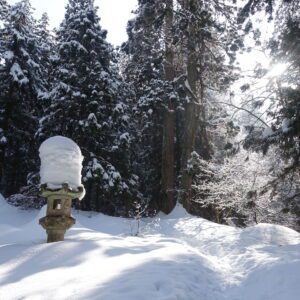

The Five-Story Pagoda is said to have been built by Taira no Masakado during the Jōhei era (931-938) in the middle of the Heian period. The current Five-Story Pagoda is said to have been rebuilt by Masauji Muto (Masauji Daihoji), the lord of Shonai about 600 years ago.
The height of the Five-Story Pagoda is about 29.2 meters. When I first saw the Five-Story Pagoda, I was wondering how the Five-Story Pagoda was built in such a mountain and was very impressed. The Five-Story Pagoda in the snow this time also stood beautifully in a sacred atmosphere, which was wonderful. There was no other person, and I was able to monopolize the Five-Story Pagoda, a national treasure.

The way back from the Five-Story Pagoda was difficult because it was a climb up the Mamakozaka to Zuishinmon. Even though it was a cold day, I got sweaty.
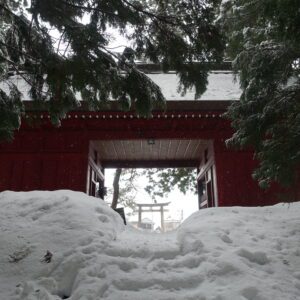
2. Mt. Haguro Sanjin Gosaiden
I returned the boots and poles at the Ideha cultural museum and took a bus to the summit of Mt. Haguro.
Depart Ideha cultural museum at 11:23, Tsuruoka Haguro summit line “bound for Haguro summit”, arrive at Haguro summit at 11:38
When you reach the summit of Mt. Haguro and go up a gentle ascent, you will see the Dewa Sanzan Historical Museum on your right. After walking a little further, you will see the red torii gate. The Dewa Sanzan Historical Museum is open from April 29th to November 23rd.
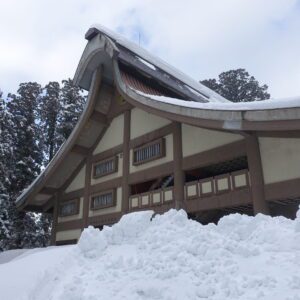

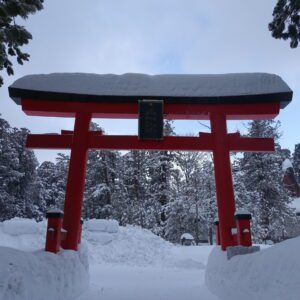
If you go through this torii gate, you will find the Sanjin Gosaiden and the Bell Tower. Both are national important cultural properties. The Sanjin Gosaiden is a thatched wooden building that enshrines the three gods of Mt. Gassan, Mt. Haguro, and Mt. Yudono, which was completed in 1818. The thatched roof is 2.1m thick and is one of the three major thatched roofs in Japan (the others are Agishi Honseiji Temple in Ishikawa Prefecture and Shoboji Temple Main Hall in Iwate Prefecture).
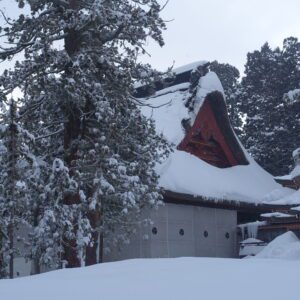
The height of the Sanjin Gosaiden is 28m, which is comparable to the Five-Story Pagoda. I was surprised at its huge size. There is a cover due to the snow, so you cannot see the details from the outside, but you can go inside and worship.
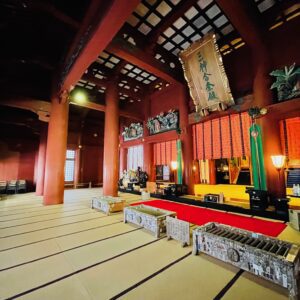
The bell tower is a thatched, gabled roof building. It was rebuilt in 1618 in the early Edo period. It is the second oldest building on Mt. Haguro after the national treasure Five-Story Pagoda. The bell was made in 1275, and it is said that after the Mongol invasion (Battle of Bunei, 1274), the Kamakura Shogunate felt the spiritual power of Mt. Haguro and dedicated it to Mt. Haguro.
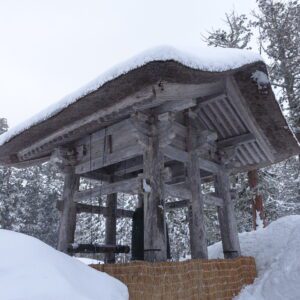
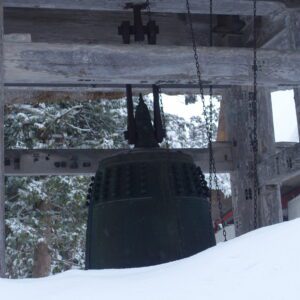
The area around the bell tower and the Sanjin Gosaiden on the summit of Mt. Haguro is a snowy mountain, and there is even a ski resort on Mt. Haguro. I am grateful that the route bus runs to such a snowy mountain. The return bus to Tsuruoka Station is as follows.
Depart Haguro summit at 12:00, Tsuruoka Haguro summit line “bound for S-MALL Bus Terminal”, arrives at Tsuruoka station at 12:54
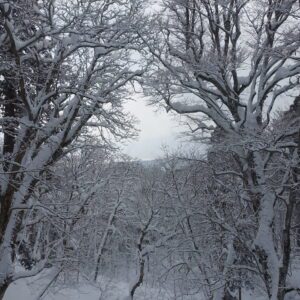
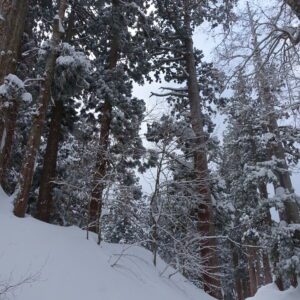
3. Kamo Aquarium
After arriving at Tsuruoka Station from Mt. Haguro, I had lunch and took a taxi to Kamo Aquarium. It takes about 30 minutes by taxi from Tsuruoka Station to Kamo Aquarium, and the fare is about Yen 4,000. There is one bus every two hours from Tsuruoka Station to Kamo Aquarium, but this time I used a taxi to save time.
This is my second visit to Kamo Aquarium. Kamo Aquarium is known by the nickname of “The Dream House of Jellies”, and there are more than 60 types of jellyfish on display. It was certified as a Guinness World Record for the number of types of jellyfish. Although the Kamo Aquarium was in a period of poor management, the exhibition of jellyfish made it one of the leading tourist destinations in the Shonai region, attracting more than 500,000 people annually.
Although it is a very popular aquarium, there were few visitors because it was the first day when “semi-state of emergency COVID-19 measures” were applied to Yamagata Prefecture. I was able to fully enjoy the Kamo Aquarium.
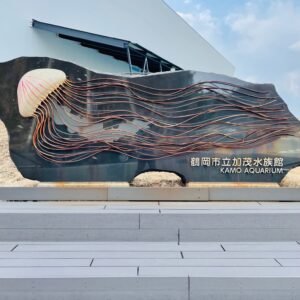
By the way, Kamo Aquarium started exhibiting jellyfish because of an accidental occurrence of jellyfish in a coral aquarium. The Green Fluorescent Protein (GFP) discovered by Osamu Shimomura, who won the Nobel Prize in Chemistry, was derived from Aequorea victoria. It was reported that the Kamo Aquarium was breeding Aequorea victoria, and it seems that the number of visits has increased dramatically.
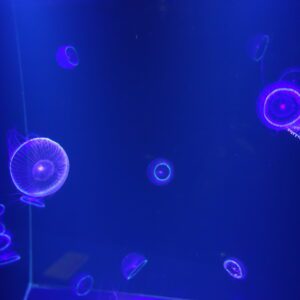
When you enter the Kamo Aquarium, various fish and shellfish are displayed before the jellyfish exhibition. Mainly fish and shellfish caught in Shonai beach.

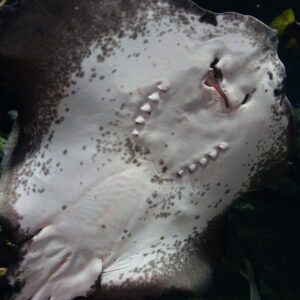

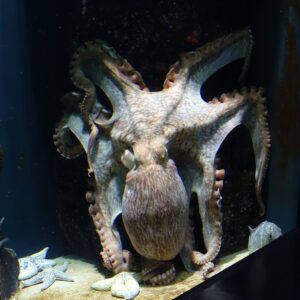
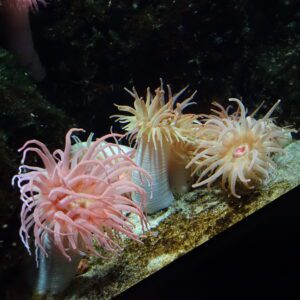
At Kamo Aquarium, the exhibition space for jellyfish is called “Kuranetarium”. The approximately 10,000 Aurelia floating in the 5-meter-diameter aquarium “Jellyfish Dream Theater” is a masterpiece. The other jellyfish tanks also feel like space.
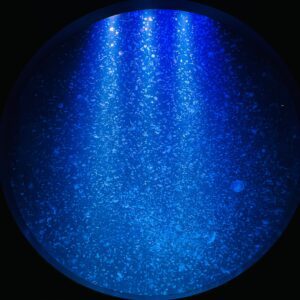
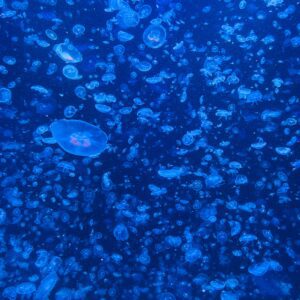
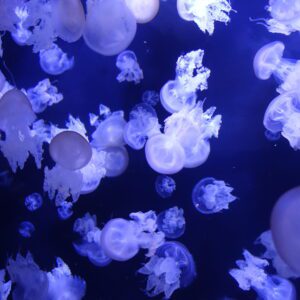
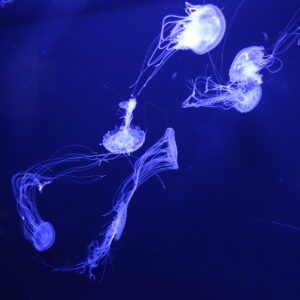
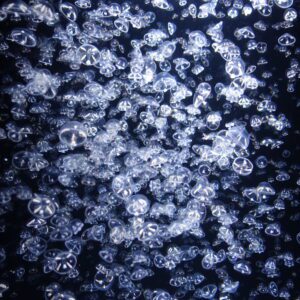
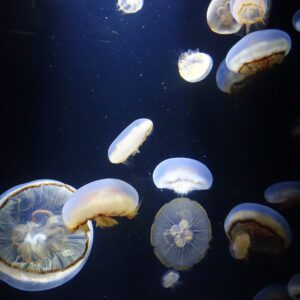
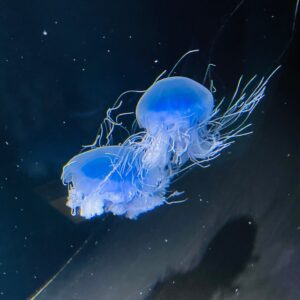
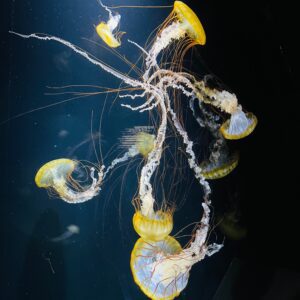
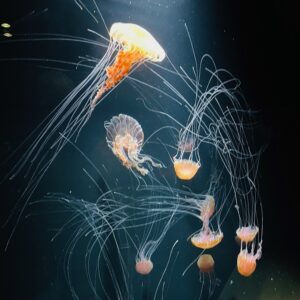
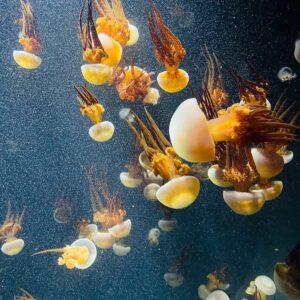
There are also sea lions and seals in the Kamo Aquarium. A harbor seal turned to me.
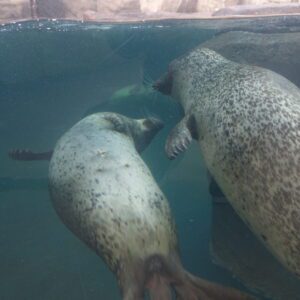

Admission fee: Yen 1,000 for adults, Yen 500 for elementary and junior high school students
After Kamo Aquarium, I went to Sakata station and had dinner.
By the way, Mt. Haguro and Kamo Aquarium can be visited on a day trip from Tokyo by taking the following planes.
Depart Haneda Airport at 7:10, ANA393, arrive at Shonai Airport at 8:10
Depart Shonai Airport at 17:45, ANA400, arrive at Haneda Airport at 18:50
Tsuruoka is also interesting except for Mt. Haguro and Kamo Aquarium, so I would like you to stay overnight. However, if you don’t have time, a day trip may be an option.
Note: The departure / arrival times, fares, admission fees, meal fees, etc. of transportation listed in the text are as of the time of writing the BLOG. Please check for yourself when you go on a trip as it may change in the future.